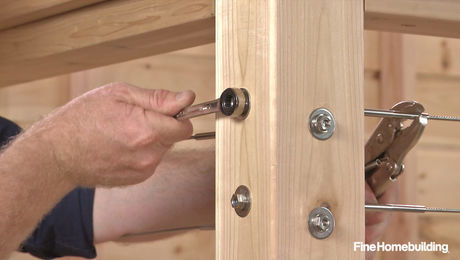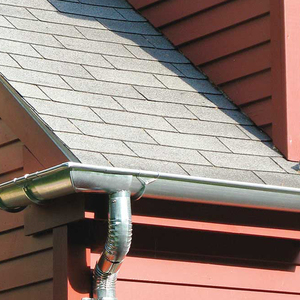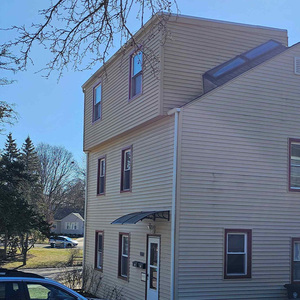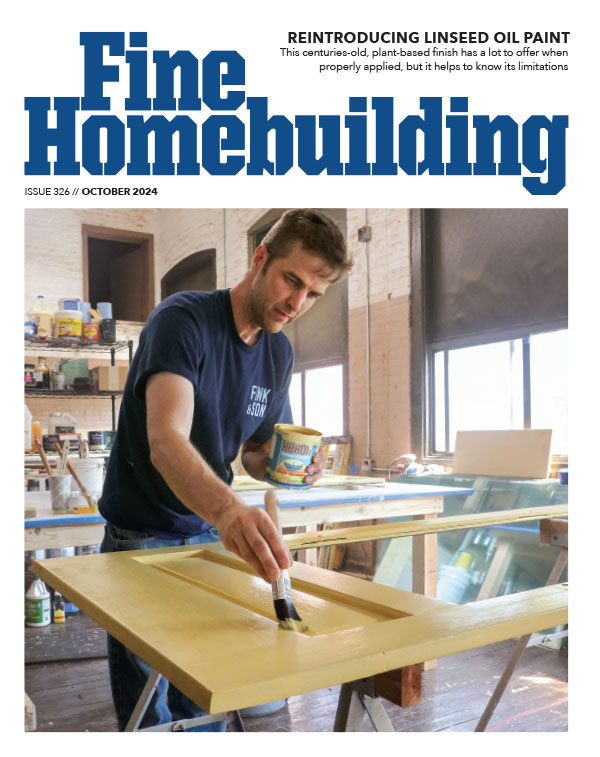I was going to go with a 42 ” pan for a step in shower. However, no since a wheelchair may be part of the equation, what can you tell me about putting in a no lip shower? Thanks.
Discussion Forum
Discussion Forum
Up Next
Video Shorts
Featured Story

The longer length of these 3-in. stair gauges makes it easier to ensure an accurate layout when working with waned lumber.
Featured Video
How to Install Cable Rail Around Wood-Post CornersHighlights
"I have learned so much thanks to the searchable articles on the FHB website. I can confidently say that I expect to be a life-long subscriber." - M.K.
Fine Homebuilding Magazine
- Home Group
- Antique Trader
- Arts & Crafts Homes
- Bank Note Reporter
- Cabin Life
- Cuisine at Home
- Fine Gardening
- Fine Woodworking
- Green Building Advisor
- Garden Gate
- Horticulture
- Keep Craft Alive
- Log Home Living
- Military Trader/Vehicles
- Numismatic News
- Numismaster
- Old Cars Weekly
- Old House Journal
- Period Homes
- Popular Woodworking
- Script
- ShopNotes
- Sports Collectors Digest
- Threads
- Timber Home Living
- Traditional Building
- Woodsmith
- World Coin News
- Writer's Digest


















Replies
I'm sure someone will be along to give you some authoritative advice, but in the meantime....
To have a true roll in shower, you really are looking at making the entire bathroom into a shower (unless it is one really large bathroom!).
How big is the bath? Can you post a diagram of the floor plan?
Do you know what size joists you have? How far do they span? They are 16" on center? 24"?
Rich Beckman
Another day, another tool.
To have a true roll in shower, you really are looking at making the entire bathroom into a shower (unless it is one really large bathroom!).
Or at least a couple of ft into the bath room itself.
I was given a set of plans with a similiar idea from and archy that had no idea how to detail the area, DUH!!
Check out Schluter Products and try you question at John Bridges Tile Forum, although no one had an answer for me when I asked.
This is NOT a doiturself kinda project!
http://www.johnbridge.com/
http://www.schluter.com/
http://www.bonsal.com/tilepage.html?sid=1376
Eric
It's Never Too Late
To Become
What You Might Have Been
yourcontractor@aol.com
You can get a fiberglass shower stall with a very low threshold, designed so that a wheelchair can roll over it. Clients of mine have one that's either 42x42 or 48x48...
I once had the same problem, how to build a "roll in" shower on a single-level floor where no adjustments to framing were possible.
Still built a "curb", but it was a ramp up and ramp down type of thing, sorta like a gently sloping speedbump. The pitch down on the shower side of the "speedbump" pitched down in a constant slope all the way to the drain. The bath was large enough so I could pull it off.
Consider small tiles/mosaics/hex's, ot a natural stone with a bit of cleft, for more grout lines and better traction.
Used Kerdi everywhere.
I was gonna suggest a wood ramp to get in ...
the trick part is getting back out!
actually ... saw a cheap retro fit once(in a big fiberglass shower unit) ... teak ramp up and in ... and a teak "grate" that made for a false floor that was even with the top of the curb.
Not sure how legal that is ... but looked and worked good.
Jeff Buck Construction
Artistry In Carpentry
Pittsburgh Pa
If they can't get back out and are stuck for a few days, at least there's no excuse for them smelling the place up.
Walk-in showers are becoming popular now that we are aging - I've done 3 recently.
Firstly, if a wheel chair is being used you will need a clear turning circle of 5' min. If the person is unaccompanied the standards of 3' beside the door will need to be considered, also.
It is preferable to reduce the depth of the joists in 2 ways - 1) a gentle slope towards the shower proper, perhaps extending 3' into the room, and sloped about 3/4" in that distance. The pan liner will extend under the tiles in this area as it allows 'overflow' to stay within the shower area. 2) reduce the depth of floor joists sufficiently to allow for a decent slope towards the drain - generally 2 3'4" (2" + 3/4" for subfloor). You will have to provide sufficient strengthening to these joists - I suggest a couple of built-up beams supported on posts below - or sistering up.
Arrange space for a seat/bench for the user, complete with grab-bars screwed thru to blocking on each side. The user may need space alongside to get out of the w/chair and onto the seat - perhaps 3' again.
Besides overhead shower heads provide at least one 'detachable' (hand held, perhaps on a pole) which can reach the back of anyone sitting on the seat, and to all areas of the w/i shower itself. Ideal for rinsing down.
Shower doors can be a hazard - do not inswing as a person who collapses inside the shower cannot be reached. (As indeed for the whole bathroom itself). It's a bit harder to w/proof outswing doors, so perhaps it's better to omit doors altogether. Just have a space min 6' deep. The sloped entry will take care of the splashes.
Don't forget things like kneeroom under the lav, grab bars to the toilet (has a bolted-down lid, too), etc.
The best thing about a room this size is it's spaciousness and air of luxury. No need for it to feel 2nd rate - create it as an indulgence rather than utilitarian!
ciao for niao
To those who know - this may be obvious. To those who don't - I hope I've helped.
Doug, we made a roll-in shower for a Habitat for Humanity house here in Orange County where a member of the recipient family is wheel-chair bound. Since we build on concrete slabs here, we simply built up the bathroom floor with mortar mix; 3/4" at the door and sloped evenly to the line where the shower pan began. From there, the slope was steeper as is typical in showers. The entire floor was tiled with ceramic tiles; 6x8 in the main floor and 4x4 in the shower. As I recall, the shower portion measured something like 59" x 39" when the tile was finished out. A shower curtain provides privacy without restricting movement either in or out.
Incidentally, this solution also required that we slope the hallway floor up to the level of the bathroom to facilitate wheelchair access and the sink was wall-mounted at an appropriate height to enable her to use it comfortably.
BruceT
Thanks for all your suggestions. These will get me back on track.